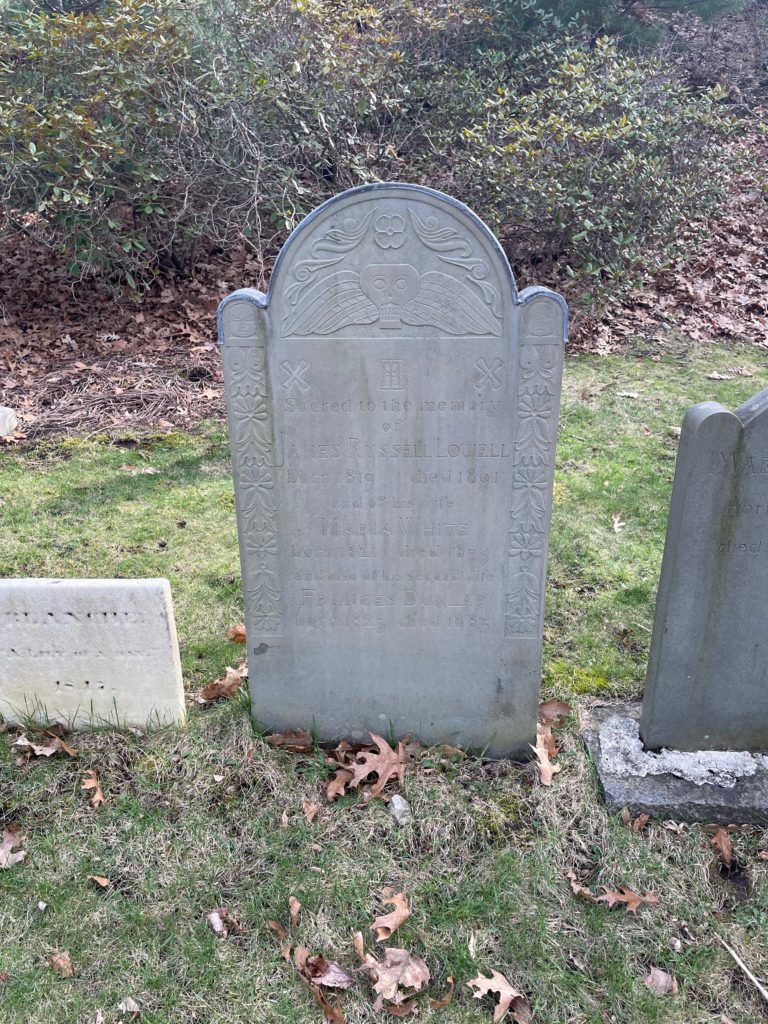Erik Visits an American Grave, Part 1,210
This is the grave of Maria White Lowell.

You might be like, wait, haven’t I seen this grave before? And the answer is yes. Back in 2019, I covered James Russell Lowell, her husband. I mentioned Maria, but I didn’t do her justice. So now this is her turn. I revisited the grave and this picture is better anyway.
Born in 1821 in Watertown, Massachusetts, Maria White grew up in the intellectual transcendentalist class. Her family was connected with the intellectual ideas of the day, including giving women not only education but encouraging them to be leaders. She was also Catholic and was placed into the Ursuline Convent in Somerville for her education. But in 1834, an anti-Catholic mob burned that convent down with religious leaders in the area such as Lyman Beecher attacking Catholics and laying the groundwork for a new wave of anti-Catholicism. I don’t believe anyone died in this burning, but White experienced these horrors and this discrimination.
By 1839, still only a young woman, White became a local leader in the women’s movement and attended the 1839 women’s rights discussion that Margaret Fuller led that was a precursor of the 1848 Seneca Falls Convention. She soon got to know a Harvard man named James Russell Lowell. They were engaged in 1840 but her father thought this guy was a loser and wouldn’t let them marry until he got a job that could support his daughter. That didn’t happen until 1844.
Maria White Lowell, as she was now known, became a leader in both the women’s rights and temperance movements. She also became a leader in the antislavery movement, thanks to Quaker friends that she knew in Philadelphia. James was something of a conservative and it was her who converted him into the reform movements of the era.
Lowell also spent her time writing poetry. This is “An Opium Fantasy”:
Soft hangs the opiate in the brain,
And lulling soothes the edge of pain,
Till harshest sound, far off or near,
Sings floating in its mellow sphere.
What wakes me from my heavy dream?
Or am I still asleep?
Those long and soft vibrations seem
A slumbrous charm to keep.
The graceful play, a moment stopp’d,
Distance again unrolls,
Like silver balls that, softly dropp’d,
Ring into golden bowls.
I question of the poppies red,
The fairy flaunting band,
While I, a weed with drooping head
Within their phalanx stand:
“Some airy one, with scarlet cap!
The name unfold to me
Of this new minstrel who can lap
Sleep in his melody!”
Bright grew their scarlet kerchiefed heads,
As freshening winds had blown,
And from their gently swaying beds
They sang in undertone,
“O he is but a little Owl,
The smallest of his kin,
Who sits beneath the Midnight’s cowl
And makes this airy din. “
“Deceitful tongues, of fiery tints,
Far more than this you know,—
That he is your Enchanted Prince
Doom’d as an owl to go.”
“Nor his fond play for years hath stopp’d
But nightly he unrolls
His silver ball that, softly dropp’d,
Ring into golden bowls.”
Alas, Lowell’s health was terrible and she no doubt knew of what she spoke with Dr. O. She had four children, which I don’t think was the root of her bad health but which most certainly did not help her get well. The couple lived mostly in Philadelphia by the late 1840s as it was less cold than Boston. But she did not really get better. Moreover, of those four children, only one reached the age of 2. So add the sorrow on top of all the other health problems.
Lowell died in 1853, probably of tuberculosis, which her symptoms and need to avoid the stuffy cold of Boston surely suggests. She was 32 years old.
In the aftermath of her death, a distraught James had a volume of her poetry published in 1855. This finally got her some attention from the literary public. That included Emily Dickinson, who considered her a major influence. Today, not too many people read mid-19th century American poetry but within that world, she’s a reasonably well respected figure.
Maria White Lowell is buried in Mount Auburn Cemetery, Cambridge, Massachusetts.
Two of Lowell’s poems are included in the Library of America’s American Poetry: The Nineteenth Century, Volume Two: Melville to Stickney, American Indian Poetry, Folk Songs and Spirituals. Those are “Rouen, Place de la Pucelle” and “An Opium Fantasy.” If you would like this series to visit other poets included in that volume, you can donate to cover the required expenses here. John Henry Hopkins, Jr., is in Burlington, Vermont and Alice Cary is in Brooklyn. Previous posts in this series are archived here.


